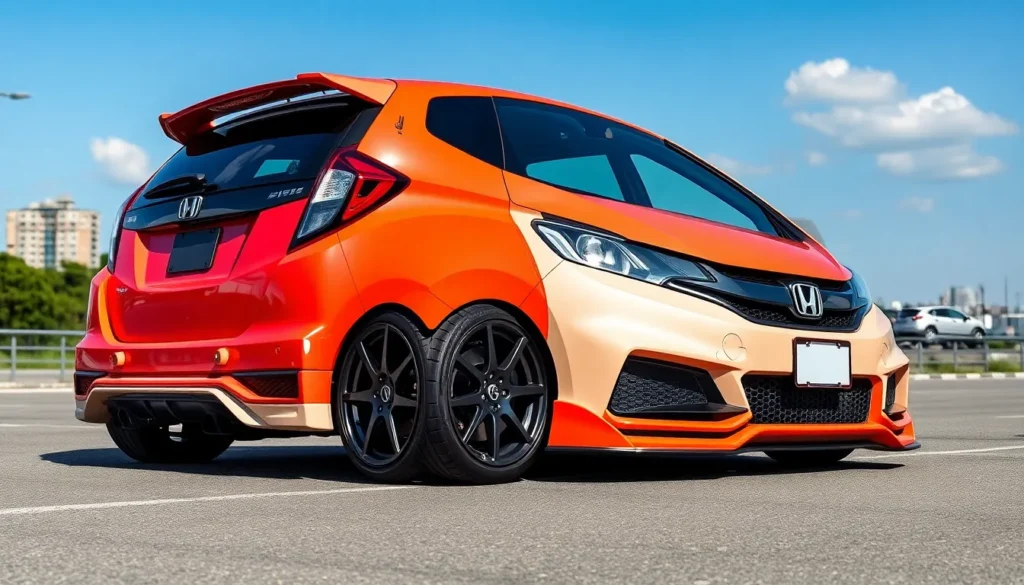When it comes to affordable tuning potential the Honda Jazz stands out as one of the most underrated gems in the compact car industry. We’ve watched countless enthusiasts transform these nimble hatchbacks into head-turning machines that deliver both style and performance without very costly.
The Jazz’s lightweight chassis and responsive handling make it an ideal canvas for modifications. Whether you’re drawn to subtle aesthetic upgrades or aggressive performance builds we’ve seen owners push these versatile vehicles far beyond their factory limits. From bolt-on performance parts to complete engine swaps the modification possibilities are virtually endless.
What makes the Jazz particularly appealing for tuners is its practical nature combined with Honda’s legendary reliability. You don’t have to sacrifice daily usability for performance gains. We’ll explore the most popular modification paths that deliver maximum impact while keeping your Jazz street-friendly and dependable for years to come.
Understanding the Honda Jazz Platform for Modifications
Before diving into exact upgrades, we need to examine what makes the Honda Jazz an excellent foundation for modifications.
Stock Specifications and Potential
Factory engines in the Honda Jazz deliver impressive efficiency while offering solid modification potential. The 1.5-liter VTEC engine produces approximately 130 horsepower and responds well to basic performance enhancements like cold air intakes and exhaust systems.
Lightweight construction gives the Jazz a important advantage over heavier competitors, with curb weights typically ranging from 2,400 to 2,600 pounds. This characteristic allows even modest power gains to translate into noticeable performance improvements.
Suspension geometry from Honda’s engineers provides a stable platform that accepts aftermarket components without major compatibility issues. The independent front suspension and torsion beam rear setup offer excellent tuning flexibility for both comfort and performance applications.
Transmission options include both manual and CVT variants, with the manual gearbox being the preferred choice for modification enthusiasts seeking direct control and better power delivery.
Common Modification Categories
Performance modifications typically focus on engine breathing improvements through aftermarket intake systems, exhaust upgrades, and ECU tuning. These changes can increase power output by 15-25% while maintaining reliability when properly executed.
Suspension upgrades transform the Jazz’s handling characteristics through coilovers, lowering springs, and sway bars. Most owners report important improvements in cornering ability and reduced body roll after implementing these changes.
Aesthetic modifications include body kits, custom wheels, and interior enhancements that personalize the vehicle’s appearance. Popular choices range from subtle lip spoilers to complete widebody conversions depending on the owner’s vision.
Brake system enhancements become necessary when adding substantial power, with upgraded pads, rotors, and stainless steel lines providing improved stopping power and pedal feel.
Budget Considerations for Honda Jazz Modified Projects
| Modification Category | Entry Level Cost | Mid-Range Cost | High-End Cost |
|---|---|---|---|
| Performance Intake | $150-300 | $300-500 | $500-800 |
| Exhaust System | $400-800 | $800-1,200 | $1,200-2,000 |
| Suspension Setup | $600-1,000 | $1,000-2,000 | $2,000-4,000 |
| Wheels and Tires | $800-1,200 | $1,200-2,500 | $2,500-5,000 |
Initial modifications should prioritize safety and drivability over outright performance, with suspension and brake upgrades forming the foundation of any serious build.
Progressive approach works best for Honda Jazz projects, allowing owners to spread costs over time while learning about their vehicle’s responses to each modification.
Quality over quantity proves essential when working with limited budgets, as properly installed mid-range components often outperform poorly fitted premium parts.
Performance Engine Modifications for Honda Jazz
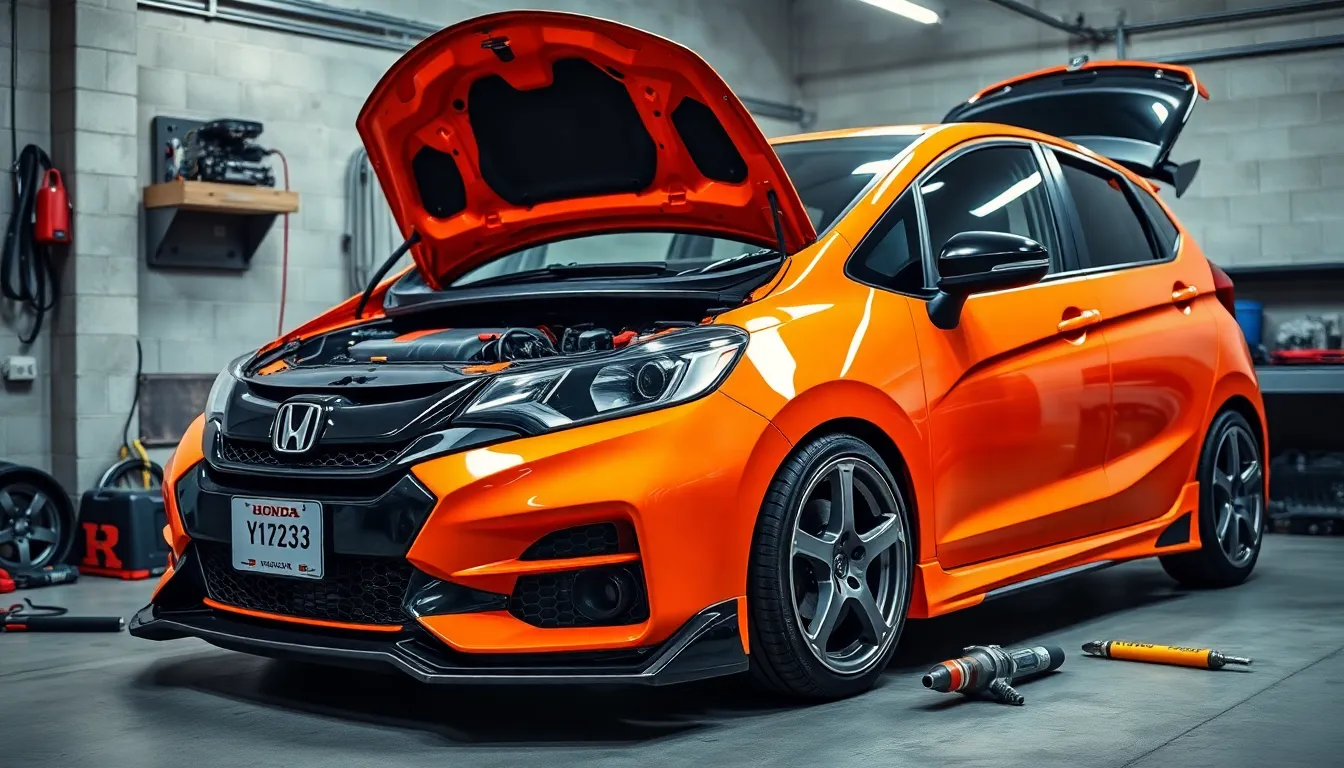
We’ll explore the most effective engine modifications that transform your Honda Jazz from a practical commuter into a responsive performance machine. These upgrades build upon the VTEC engine’s inherent strengths while maintaining daily drivability.
Cold Air Intake Systems
Cold air intakes represent the most cost-effective entry point for Honda Jazz engine modifications. These systems replace the restrictive factory airbox with high-flow filters and smoother intake pipes. We typically see gains of 8-12 horsepower from quality cold air intake installations on the 1.5-liter VTEC engine.
Performance improvements become noticeable immediately after installation. The enhanced airflow allows your engine to breathe more efficiently while producing a more aggressive induction sound. Popular brands like AEM, K&N, and Injen offer bolt-on answers specifically designed for the Jazz platform.
Installation requires basic hand tools and takes approximately 2-3 hours for most enthusiasts. The modification doesn’t void your warranty when installed properly and can be easily reversed if needed. We recommend combining cold air intakes with complementary modifications like exhaust systems for optimal results.
Exhaust System Upgrades
Exhaust system modifications deliver both performance gains and enhanced sound characteristics for your Honda Jazz. Cat-back exhaust systems typically add 10-15 horsepower while reducing backpressure throughout the rev range. These systems work particularly well with the VTEC engine’s high-rpm power delivery.
Header upgrades provide the most important performance benefits in the exhaust category. Aftermarket headers like those from Skunk2 or DC Sports can add 15-20 horsepower by improving exhaust gas scavenging. The combination of headers with cat-back systems often yields gains exceeding 25 horsepower.
Sound enhancement varies dramatically between different exhaust configurations. We’ve found that resonated systems maintain civility for daily driving while straight-through designs create aggressive exhaust notes. Popular options include single-exit systems for weight savings or dual-exit setups for visual appeal.
ECU Tuning and Remapping
ECU tuning unlocks the full potential of your Honda Jazz engine modifications. Professional remapping optimizes fuel delivery, ignition timing, and VTEC engagement points to work seamlessly with your upgraded components. We typically observe gains of 20-30 horsepower from comprehensive ECU tuning on modified Jazz engines.
Standalone engine management systems offer maximum flexibility for serious builds. Units like Hondata K-Pro or AEM Infinity allow precise control over every aspect of engine operation. These systems become essential when adding forced induction or extensive internal modifications.
Piggyback ECU systems provide a budget-friendly tuning alternative. Products like Hondata FlashPro offer pre-loaded maps for common modification combinations while maintaining OBD-II functionality. We recommend professional dyno tuning regardless of the ECU solution chosen for optimal results.
Turbocharger and Supercharger Installations
Forced induction represents the ultimate power upgrade for Honda Jazz enthusiasts. Turbocharger kits can double the stock engine’s output while supercharger systems provide immediate throttle response. We’ve documented builds producing 200-250 horsepower from properly executed forced induction installations.
Turbocharger systems offer the best power-to-cost ratio for serious performance builds. Garrett GT series turbos work exceptionally well with the VTEC engine’s characteristics when properly sized. Supporting modifications like upgraded internals, fuel systems, and cooling become necessary at higher boost levels.
Supercharger installations provide linear power delivery throughout the rev range. Jackson Racing and Kraftwerks offer bolt-on supercharger kits specifically engineered for Honda applications. These systems typically produce 160-180 horsepower while maintaining excellent drivability for street use.
Supporting modifications become critical when adding forced induction to your Jazz. Upgraded fuel injectors, high-flow fuel pumps, and intercooler systems ensure reliable operation under boost conditions. We always recommend professional installation and tuning for forced induction systems to prevent engine damage.
Suspension and Handling Modifications
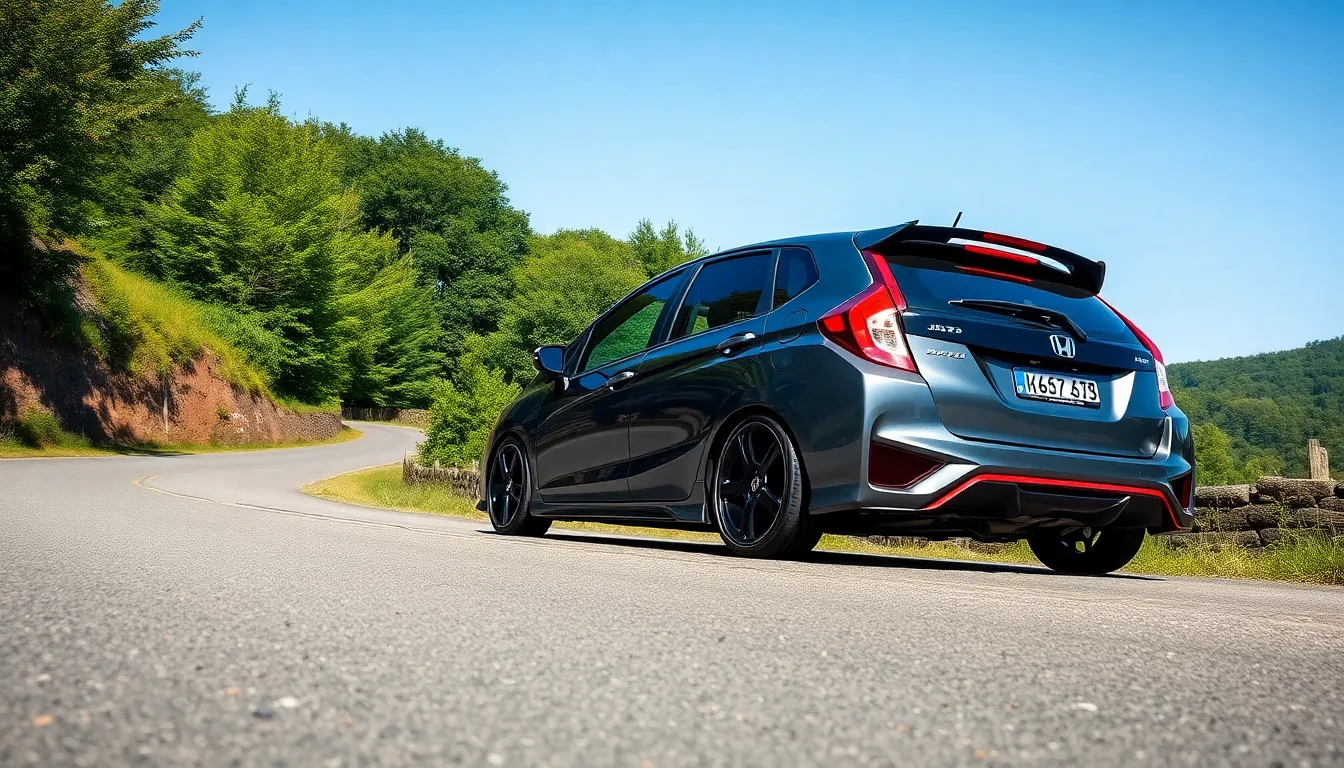
The Honda Jazz platform truly shines when we focus on suspension and handling improvements. These modifications transform the car’s ever-changing capabilities while maintaining its daily driving comfort.
Lowering Springs and Coilovers
Lowering springs provide the most affordable entry point into suspension modifications for Honda Jazz owners. We recommend drops of 1.5 to 2 inches to maintain practicality while achieving improved aesthetics and handling. Quality brands like Eibach Pro Kit or H&R Sport Springs offer excellent value with gains in cornering stability and reduced body roll.
Coilover systems deliver superior adjustability and performance compared to lowering springs alone. Popular options include BC Racing BR series and Tein Street Basis coilovers, which typically cost $800 to $1,500. These systems allow precise ride height adjustment and damping tuning to match driving preferences. Professional installation ensures proper alignment and optimal performance from coilover setups.
Sway Bars and Strut Braces
Front and rear sway bars dramatically reduce body roll during aggressive cornering without compromising ride quality. Aftermarket sway bars for the Honda Jazz typically measure 22-24mm front and 18-20mm rear compared to stock dimensions. We’ve observed important improvements in corner entry confidence and overall chassis balance with quality sway bar upgrades.
Strut tower braces connect the suspension mounting points to reduce chassis flex under load. Upper strut bars provide noticeable steering response improvements, especially when combined with lower tie bars. These modifications cost $100 to $300 and install easily with basic tools. The combination of sway bars and strut braces creates a more connected driving experience.
Performance Tires and Wheel Upgrades
Tire upgrades deliver the most immediate handling improvements for any Honda Jazz build. We recommend sizes like 195/50R16 or 205/45R17 with performance compounds from Michelin Pilot Sport, Bridgestone Potenza, or Continental ExtremeContact series. These tires provide significantly better grip and feedback compared to economy tire options.
Lightweight wheels reduce unsprung weight and improve acceleration, braking, and handling response. Popular sizes include 16×7 or 17×7.5 inch wheels with appropriate offset for the Jazz platform. Quality forged or flow formed wheels from brands like Enkei, OZ Racing, or Work Wheels offer substantial weight savings. Each pound of unsprung weight reduction equals approximately 4 pounds of regular weight reduction in terms of performance impact.
Brake System Enhancements
Upgraded brake pads provide improved stopping power and fade resistance during spirited driving sessions. Performance compounds like Hawk HPS or EBC RedStuff offer excellent street performance without excessive dust or noise. These pads work effectively with stock rotors for most driving applications.
Larger brake rotors and calipers become necessary when adding important power or for track use. Front brake upgrades typically involve 11.75 to 12.6 inch rotors compared to the stock 10.3 inch units. Brands like StopTech, Wilwood, and Brembo offer complete big brake kits ranging from $1,200 to $2,500. Stainless steel brake lines and high performance brake fluid complete the braking system upgrades for maximum pedal feel and consistency.
Exterior Styling Modifications

After upgrading your Honda Jazz’s performance and handling capabilities, visual modifications help complete the transformation. Exterior styling changes allow you to express personal taste while improving the overall aesthetic appeal of your modified Jazz.
Body Kit Installation Options
Full body kit packages transform your Honda Jazz’s appearance dramatically, typically including front and rear bumpers, side skirts, and spoilers. Companies like Mugen, Spoon Sports, and J’s Racing offer comprehensive kits ranging from $800 to $2,500, depending on material quality and complexity. We recommend starting with subtle lip spoilers and side splitters before investing in complete body kit overhauls.
Front bumper modifications create aggressive styling through lower lip spoilers, canards, and integrated fog light housings. Popular options include the Mugen RR-style front lip ($300-500) and carbon fiber splitters ($200-400) that enhance aerodynamics while improving visual appeal. These modifications require careful fitment to maintain proper ground clearance for daily driving practicality.
Side skirt installations provide a lowered appearance and improved airflow management along the vehicle’s flanks. Aftermarket side skirts from brands like Spoon Sports and Type R replicas cost between $250-600 per set, with fiberglass options offering affordability while carbon fiber variants provide premium aesthetics and weight reduction.
Custom Paint Jobs and Vinyl Wraps
Professional paint jobs allow complete color transformation with options ranging from metallic finishes to pearl effects and matte surfaces. Quality paint work costs between $3,000-8,000 depending on preparation requirements, color complexity, and finish quality. We suggest choosing colors that complement your Jazz’s compact proportions while maintaining resale value considerations.
Vinyl wrap applications provide temporary styling changes at lower costs, typically ranging from $1,500-3,500 for full vehicle coverage. Popular wrap styles include carbon fiber textures, racing stripes, chrome accents, and color-changing films that shift appearance under different lighting conditions. These wraps protect original paint while allowing easy removal for future modifications.
Custom graphics packages incorporate racing numbers, sponsor decals, and unique design elements that personalize your Honda Jazz’s appearance. Professional vinyl cutting services create precision graphics starting at $200-800, depending on design complexity and coverage area. These additions work particularly well with motorsport-inspired builds.
Aerodynamic Upgrades
Rear wing installations improve high-speed stability while creating distinctive visual impact through various profiles and mounting styles. Popular options include adjustable GT-style wings ($400-1,200) and subtle decklid spoilers ($150-400) that complement the Jazz’s hatchback design. We recommend wings with adjustable angles for fine-tuning aerodynamic balance during track events.
Front splitter systems direct airflow underneath the vehicle while reducing front-end lift at highway speeds. Carbon fiber splitters ($300-800) offer the best strength-to-weight ratio, while fiberglass alternatives ($150-400) provide budget-friendly options. Proper installation requires attention to approach angles and daily driving clearance requirements.
Underbody paneling smooths airflow beneath the Honda Jazz, reducing drag and improving fuel efficiency during highway driving. Complete undertray kits cost $200-600 and work best when combined with other aerodynamic modifications for comprehensive airflow management.
LED Lighting Modifications
Headlight conversions modernize your Jazz’s appearance through LED or HID retrofit systems that improve visibility while creating distinctive lighting signatures. Quality LED headlight assemblies range from $400-1,200, with plug-and-play options requiring minimal installation complexity. We recommend units with proper beam patterns to avoid blinding oncoming traffic.
Daytime running light installations enhance safety while adding contemporary styling through various LED strip configurations and accent lighting. Popular DRL options include fog light bezels with integrated LEDs ($100-300) and custom headlight modifications ($200-500) that create unique lighting signatures.
Interior and exterior accent lighting creates ambient effects through underbody kits, interior footwell lighting, and dashboard illumination systems. LED strip kits cost between $50-200 and offer customizable colors through smartphone app control. These modifications work particularly well with dark-colored Jazz builds where subtle lighting creates dramatic contrast effects.
Interior Customization Ideas
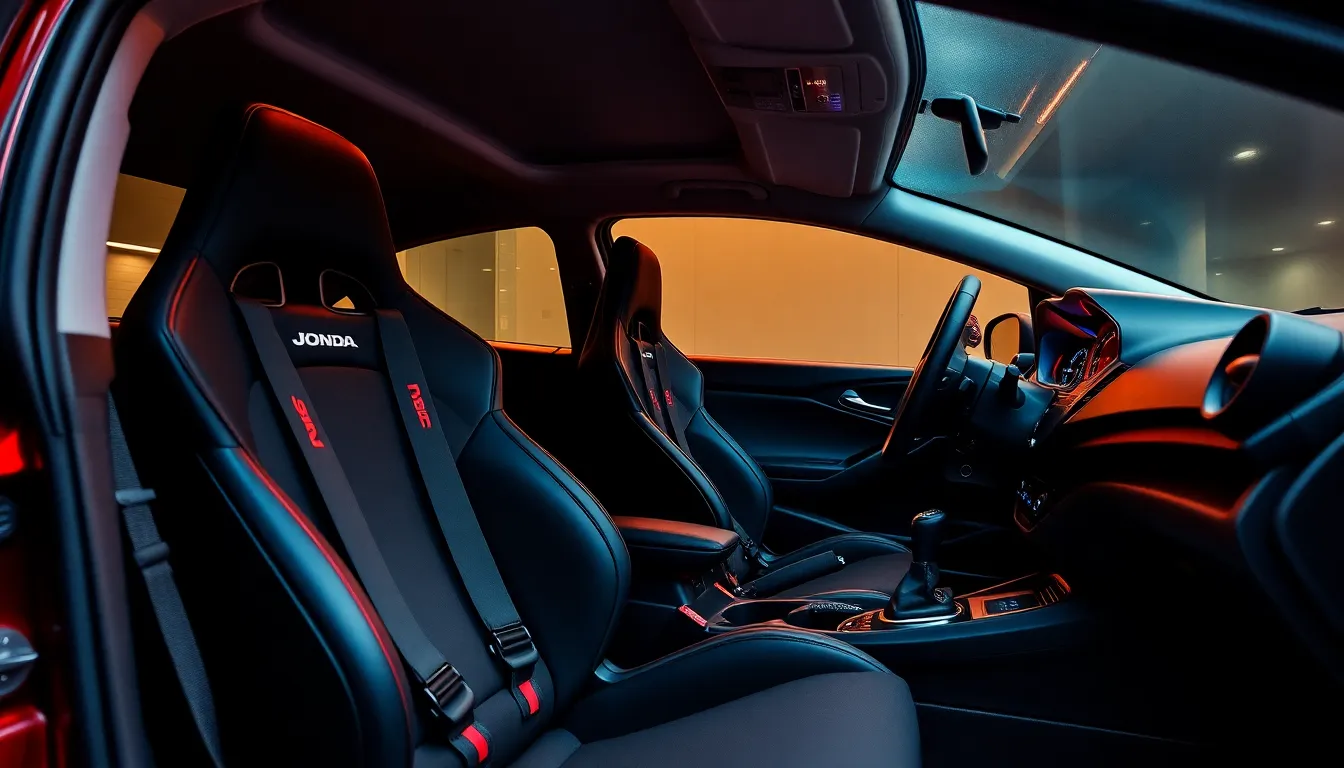
Interior modifications transform our Honda Jazz into a personalized cockpit that reflects our unique style while improving the driving experience.
Racing Seats and Harnesses
Racing seats replace the factory Honda Jazz seats with performance-focused alternatives that provide superior support during spirited driving. We recommend Recaro Sportster CS seats or Sparco Sprint models, which typically cost between $400-800 per seat and offer excellent lateral support. Bucket seats reduce overall weight by 15-20 pounds compared to stock seats while improving our driving position.
Four-point or five-point racing harnesses complement aftermarket seats by keeping us securely positioned during cornering. Takata or Sabelt harnesses range from $150-300 and mount to reinforced chassis points or harness bars. Installing harness bars requires welding or bolt-in answers that distribute loads across the Jazz’s structure.
Seat rail adapters ensure proper fitment of aftermarket seats to our Honda Jazz’s floor pan. We’ll need exact brackets for our model year, which cost approximately $100-150 per seat. Professional installation ensures proper positioning and meets safety requirements for track use.
Custom Dashboard and Gauge Clusters
Digital gauge clusters replace the Honda Jazz’s analog instruments with modern LCD or OLED displays showing comprehensive engine data. AEM CD-7 or AiM MXL2 units cost $800-1,500 and display boost pressure, air-fuel ratios, and lap times. These systems integrate with engine management systems to provide real-time performance feedback.
Custom dashboard overlays cover existing trim pieces with carbon fiber, aluminum, or painted finishes. We can source overlays from vendors like JDMuscle or create custom pieces using vinyl wrapping techniques. Carbon fiber dash kits typically cost $200-400 and dramatically change the interior’s aesthetic.
Additional gauges monitor critical engine parameters not displayed in the stock cluster. Oil pressure, water temperature, and boost gauges mount in A-pillar pods or custom dashboard locations. Defi or GReddy gauges cost $100-200 each and provide essential monitoring for modified engines.
Steering wheel upgrades replace the factory Honda Jazz wheel with smaller diameter racing wheels from Momo, Sparco, or OMP. These wheels typically measure 320-350mm in diameter and cost $150-400. Quick-release hubs allow rapid wheel removal for security or racing applications.
Audio System Upgrades
Component speaker systems replace the Honda Jazz’s factory speakers with higher-quality drivers for improved sound clarity. Focal Access or Pioneer TS-A series speakers cost $200-500 and require minimal modifications to factory mounting locations. We recommend upgrading front speakers first for maximum impact.
Subwoofer installations add low-frequency response to our Jazz’s audio system without compromising cargo space. Compact powered subwoofers like the JL Audio CP108LG fit under seats or in small enclosures. Alternatively, we can build custom subwoofer boxes that maximize available space while maintaining practicality.
Amplifier upgrades power our new speakers and subwoofers with clean, distortion-free signal. Alpine or Rockford Fosgate amplifiers provide 75-150 watts per channel and mount under seats or in the cargo area. Sound dampening materials reduce road noise and improve audio quality by minimizing vibrations.
Head unit replacements modernize our Honda Jazz with Apple CarPlay, Android Auto, and Bluetooth connectivity. Pioneer or Kenwood units cost $200-600 and integrate with steering wheel controls. We’ll need installation harnesses and trim pieces to maintain factory appearance.
Interior Trim and Accent Modifications
Carbon fiber trim pieces replace plastic interior panels with lightweight, premium-looking alternatives. Real carbon fiber costs $300-600 for complete interior kits, while vinyl wrapping existing trim costs $50-150. Door panels, center console covers, and shift surrounds create cohesive styling throughout the cabin.
LED interior lighting upgrades replace incandescent bulbs with energy-efficient LEDs that produce brighter, whiter light. Complete LED conversion kits cost $30-80 and include dome lights, map lights, and footwell illumination. Color-changing LED strips add ambient lighting effects for evening driving.
Custom shift knobs and gear boots personalize our manual transmission Jazz with aluminum, carbon fiber, or weighted options. Short shifters reduce throw distance by 30-40% for quicker gear changes. We recommend brands like Buddy Club or Skunk2 for quality and fitment.
Floor mat upgrades protect our Honda Jazz’s carpets while adding style through custom embroidery or colored stitching. WeatherTech or Husky Liners provide all-weather protection, while Lloyd Mats offer luxury carpet options with custom logos. Racing-style floor mats feature heel plates and driver-focused designs.
Popular Honda Jazz Modified Build Examples

These modified Honda Jazz builds showcase the platform’s versatility and demonstrate how different approaches can transform this practical hatchback into something truly special.
Street Performance Builds
Balanced power and practicality define successful street performance Jazz builds that maintain daily drivability while delivering enhanced performance. Most builders start with a cold air intake system paired with a cat-back exhaust, typically yielding 15-20 additional horsepower for around $800-1,200 total investment. ECU remapping follows these initial modifications, unlocking another 20-25 horsepower while optimizing fuel delivery and ignition timing.
Suspension upgrades in street builds commonly feature adjustable coilovers lowered 1.5-2 inches, providing improved handling without compromising ride quality over everyday road conditions. Popular choices include BC Racing BR series or Tein Street Flex coilovers priced between $1,000-1,500. Anti-roll bars and strut tower braces complete the handling package, typically adding $300-500 to the build cost.
Wheel and tire combinations focus on lightweight 16-17 inch wheels with performance tires that balance grip with comfort. Many builders choose 205/45R17 or 195/50R16 sizing to maintain proper speedometer calibration while improving cornering capabilities.
Show Car Transformations
Visual impact drives show car Jazz builds through dramatic styling modifications that completely transform the vehicle’s appearance. Full body kits featuring aggressive front bumpers, side skirts, and rear diffusers create a cohesive visual package, with quality fiberglass kits ranging from $1,500-3,000 before paint and installation.
Custom paint schemes often incorporate multi-color fades, metallic finishes, or vibrant single colors that make these Jazz builds stand out at automotive events. Professional paint jobs for show cars typically cost $3,000-6,000 depending on complexity and preparation requirements.
Interior transformations include custom leather upholstery, digital gauge clusters, and premium audio systems with multiple amplifiers and subwoofers. Racing seats with matching harnesses provide both visual appeal and improved support, while carbon fiber trim pieces add modern touches throughout the cabin.
Attention to detail separates exceptional show builds through elements like color-matched engine bay components, custom air ride suspension systems, and intricate wire management that creates a clean, professional appearance under the hood.
Track-Ready Modifications
Performance focused modifications prioritize handling precision and driver safety over aesthetic considerations in track-prepared Jazz builds. Roll cages provide essential safety protection while significantly increasing chassis rigidity, typically costing $2,000-3,500 for professional installation.
Suspension setups use aggressive spring rates and damper settings optimized for smooth racing surfaces rather than street comfort. Track-exact coilovers like Ohlins or AST systems offer precise adjustability but cost $2,500-4,000 for complete packages.
Brake system upgrades become critical for repeated hard stops during track sessions, with many builders installing larger 300mm rotors, multi-piston calipers, and high-temperature brake pads. Complete brake upgrades typically require $2,000-3,500 investments for reliable track performance.
Weight reduction efforts remove unnecessary interior components, replace body panels with lightweight alternatives, and eliminate sound deadening materials to improve power-to-weight ratios. Successful track builds often reduce vehicle weight by 200-300 pounds through systematic component removal.
Daily Driver Enhancement Projects
Subtle improvements characterize daily driver Jazz builds that enhance the ownership experience without drawing unwanted attention or compromising reliability. Mild lowering springs reduce ride height by 1-1.5 inches while maintaining OEM shock absorbers, providing improved appearance for $200-400.
Comfort and convenience upgrades include premium audio systems with smartphone integration, LED interior lighting conversions, and ergonomic aftermarket steering wheels. These modifications enhance daily usability while preserving the Jazz’s practical nature and fuel efficiency.
Modest performance gains come through simple bolt-on modifications like drop-in air filters, throttle body spacers, and mild exhaust systems that add 5-10 horsepower without requiring ECU modifications or premium fuel requirements.
Maintenance friendly modifications focus on components that don’t complicate routine service or void warranty coverage, making them ideal for owners who depend on their Jazz for reliable transportation while enjoying mild performance and aesthetic improvements.
Essential Tools and Resources for Modification
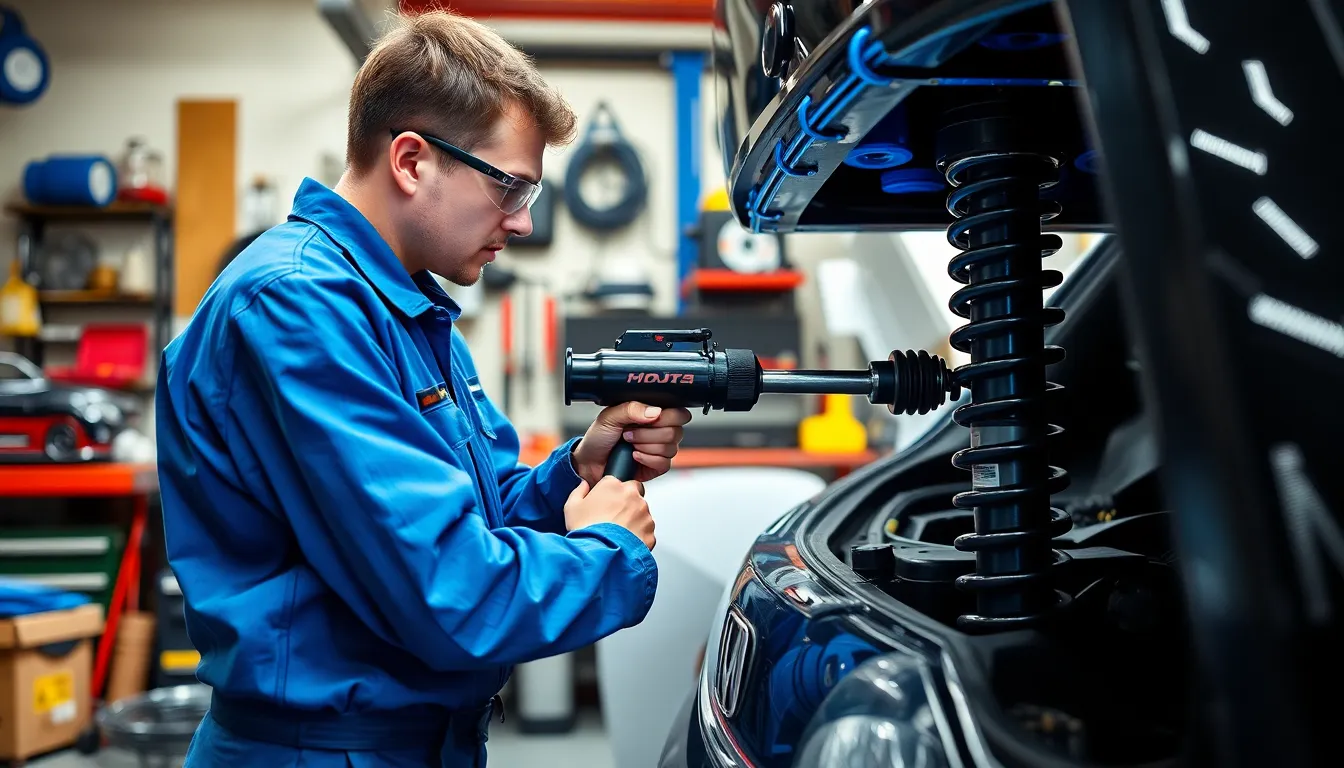
We’ll guide you through the must-have tools and resources that make Honda Jazz modification projects successful and cost-effective.
Required Tools for DIY Projects
Socket and wrench sets form the foundation of any Honda Jazz modification toolkit. We recommend investing in a comprehensive metric socket set ranging from 8mm to 19mm, as these sizes cover most Jazz components including suspension bolts, engine mounts, and interior trim pieces. Quality ratcheting wrenches save important time during repetitive tasks like header installation or suspension work.
Jack stands and floor jacks ensure safety when working under your Jazz. We always use a minimum 2-ton capacity floor jack with jack stands rated for your vehicle’s weight. Honda Jazz models typically weigh around 2,500 pounds, making 3-ton stands the ideal safety margin for most projects.
Torque wrenches prevent costly damage from over-tightening critical components. We suggest having both 1/4-inch and 1/2-inch drive torque wrenches to handle everything from delicate interior trim (5-10 ft-lbs) to suspension components (80-100 ft-lbs).
Electrical tools become essential for lighting upgrades and electronic modifications. Basic multimeters, wire strippers, crimping tools, and heat shrink tubing handle most electrical projects on the Jazz platform.
Professional Installation Services
Honda specialty shops offer expertise exact to the Jazz platform and VTEC engine systems. We recommend seeking shops with demonstrated experience in Honda tuning, particularly those familiar with the L15A engine found in most Jazz models.
Performance tuning centers provide ECU calibration services that maximize modification benefits. Shops equipped with dyno facilities can properly tune cold air intake and exhaust combinations, typically yielding 10-15 additional horsepower on the Jazz platform.
Suspension specialists ensure proper alignment and corner balancing after lowering spring or coilover installation. We’ve found that professional alignment services prevent premature tire wear and maintain the Jazz’s excellent handling characteristics.
Paint and body shops handle complex aesthetic modifications like body kit installation and custom paint work. Quality shops familiar with fiberglass and polyurethane materials deliver professional results that complement the Jazz’s compact proportions.
Online Communities and Forums
Honda-Tech forums serve as the primary resource for Jazz modification advice and technical specifications. We regularly reference their extensive modification guides and member build threads for project inspiration and troubleshooting assistance.
Reddit communities like r/Honda and r/JDM provide active discussion platforms for sharing Jazz modification progress. These communities offer real-time feedback and cost-effective solution recommendations from fellow enthusiasts.
Facebook groups dedicated to Honda Jazz owners share local vendor recommendations and regional meet-up information. We’ve discovered many parts suppliers and installation services through these targeted communities.
YouTube channels demonstrate step-by-step modification procedures exact to the Jazz platform. Visual learners benefit from detailed installation videos that show proper techniques for complex procedures like turbocharger installation or suspension upgrades.
Parts Suppliers and Vendors
Honda OEM dealers provide genuine replacement parts and performance components like Mugen accessories designed specifically for the Jazz. We often source engine internals and transmission components through authorized dealers to ensure compatibility and warranty coverage.
Performance retailers like K-Tuned and Skunk2 offer aftermarket components engineered for Honda platforms. These vendors typically stock cold air intakes, exhaust systems, and suspension components with proven Jazz compatibility.
Online marketplaces including eBay and Amazon provide access to international suppliers and rare OEM parts. We recommend verifying part numbers and seller ratings when sourcing components from these platforms.
Local salvage yards serve as cost-effective sources for donor parts and upgrade components from higher-trim Jazz models. We’ve successfully sourced everything from sport seats to larger brake calipers through established relationships with reputable salvage operations.
Legal Considerations and Safety Guidelines
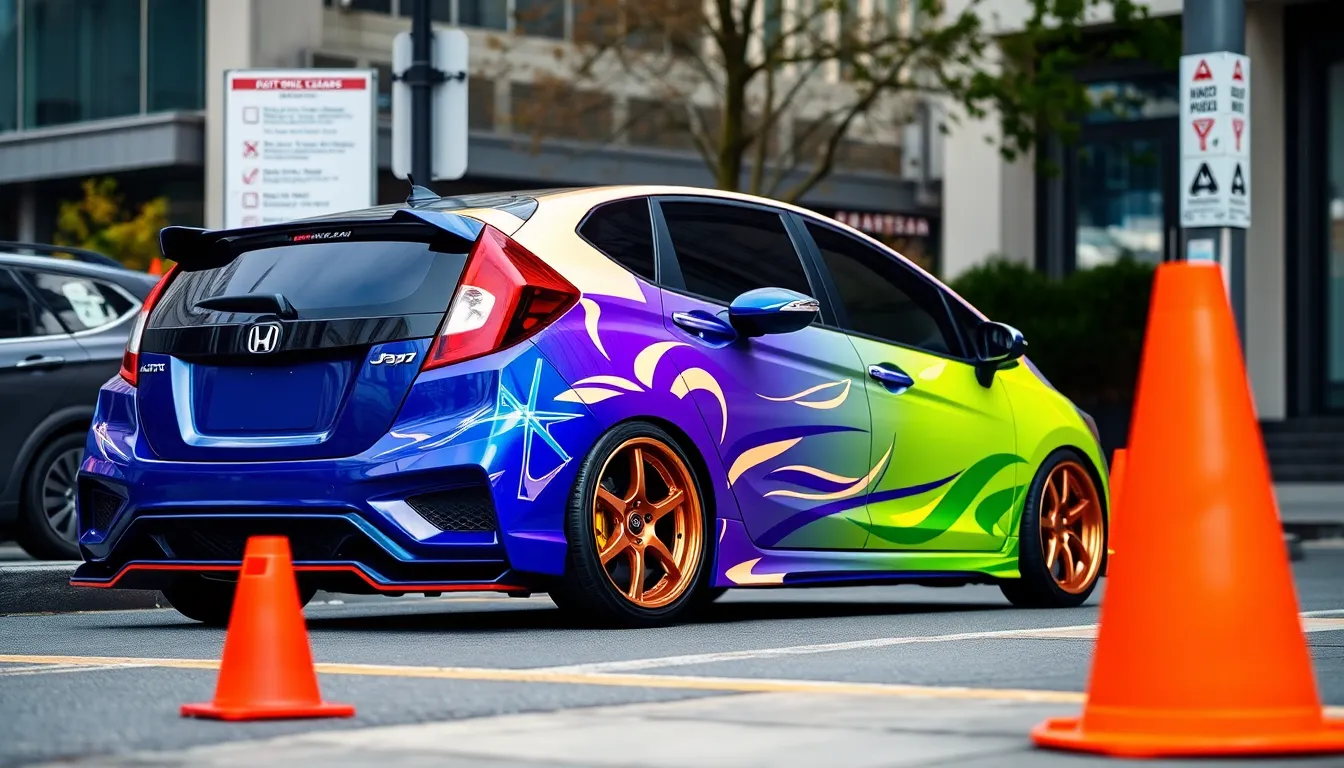
Handling the legal industry of Honda Jazz modifications requires careful attention to local regulations and safety standards. We’ll explore the essential legal requirements and safety practices that ensure your modified Jazz remains compliant and roadworthy.
Local Modification Laws and Regulations
State and federal emissions standards dictate which engine modifications we can legally carry out on our Honda Jazz. Most states require modified vehicles to pass emissions testing, limiting the extent of exhaust system changes and ECU tuning parameters we can apply.
Height and lighting restrictions vary significantly across jurisdictions, affecting suspension modifications and aftermarket lighting installations. California’s strict vehicle code, for example, prohibits lowering vehicles below exact ground clearance measurements and restricts LED headlight conversions without proper DOT certification.
Sound ordinances in many municipalities limit exhaust system decibel levels, typically capping noise at 95 decibels measured from 50 feet away. We must research local noise regulations before installing performance exhaust systems or removing catalytic converters.
Vehicle inspection requirements in states like Texas and Pennsylvania mandate annual safety inspections that scrutinize modified components. Suspension alterations, brake system upgrades, and wheel modifications must maintain factory safety specifications to pass these inspections.
Insurance Implications
Modification disclosure to insurance providers protects us from claim denials and policy cancellations. We must report performance upgrades, suspension modifications, and aesthetic changes that increase our Honda Jazz’s value or alter its risk profile.
Premium increases typically range from 10% to 25% for declared modifications, depending on the extent of changes and our driving history. Performance modifications like turbocharging or supercharging often result in higher premium adjustments than cosmetic upgrades.
Agreed value policies provide better protection for heavily modified Honda Jazz builds, ensuring we receive fair compensation that reflects our investment in aftermarket parts. Standard policies may only cover stock vehicle values, leaving us undercompensated for modification costs.
Specialty insurance providers like Hagerty and Grundy offer modified vehicle coverage with lower premiums and better understanding of enthusiast modifications. These companies often provide coverage for track day events and car show participation that standard insurers exclude.
Safety Inspections and Certifications
Professional alignment services become essential after suspension modifications, ensuring our Honda Jazz maintains proper handling characteristics and tire wear patterns. We should perform alignments within 500 miles of any suspension component installation.
Brake system inspections must verify that upgraded components maintain proper pedal feel and stopping distances. Modified brake systems require professional evaluation to ensure compatibility between different manufacturers’ components and proper hydraulic pressure distribution.
Electrical system safety checks prevent fire hazards from aftermarket installations like amplifiers, LED lighting, and performance monitoring equipment. We should have qualified technicians inspect all electrical modifications to verify proper fusing, grounding, and wire gauge specifications.
Structural integrity assessments for body modifications ensure that aerodynamic additions and cosmetic changes don’t compromise crash safety or create road hazards. Professional installation shops can verify that body kits and spoilers attach securely using appropriate mounting hardware.
Proper Installation Practices
Torque specifications for suspension components and wheel installations prevent dangerous failures that could result in loss of vehicle control. We must use calibrated torque wrenches and follow manufacturer specifications for all critical fasteners on our Honda Jazz modifications.
Supporting modifications ensure that performance upgrades work harmoniously without creating reliability issues. Engine modifications require corresponding fuel system, cooling system, and drivetrain upgrades to handle increased power output safely.
Quality parts sourcing from reputable manufacturers reduces the risk of component failures that could endanger vehicle occupants. We should prioritize OEM equivalent or higher quality aftermarket parts over budget alternatives for safety critical systems.
Professional consultation for complex modifications like turbocharging or roll cage installation ensures proper execution and safety compliance. Experienced Honda specialists can identify potential issues and recommend supporting modifications before problems arise.
Conclusion
The Honda Jazz represents one of today’s most promising platforms for automotive modification enthusiasts. We’ve explored how this compact hatchback’s lightweight design and reliable VTEC engine create an ideal foundation for both performance upgrades and aesthetic enhancements.
Whether you’re planning a budget-friendly daily driver enhancement or an ambitious show car transformation the Jazz delivers exceptional value. Its responsive handling characteristics and proven reliability mean you won’t sacrifice practicality for performance.
Remember that successful modifications require careful planning proper installation and adherence to local regulations. With the right approach and resources we’ve outlined your Honda Jazz can become a unique expression of your automotive passion while maintaining the dependability Honda is known for.
Frequently Asked Questions
Is the Honda Jazz a good car for tuning and modifications?
Yes, the Honda Jazz is an excellent choice for affordable tuning. Its lightweight design, responsive handling, and reliable 1.5-liter VTEC engine make it ideal for modifications. The platform responds well to performance upgrades while maintaining daily practicality and Honda’s proven reliability, making it perfect for both beginners and experienced tuners.
What engine modifications work best for the Honda Jazz?
Popular engine modifications include cold air intake systems, cat-back exhaust upgrades, ECU tuning, and performance chips. The 1.5-liter VTEC engine responds well to these modifications, potentially increasing the stock 130 horsepower significantly. For more power, forced induction options like turbochargers are available but require supporting modifications.
How much should I budget for Honda Jazz modifications?
Modification costs vary by category. Basic performance upgrades (intake, exhaust) cost $500-$1,500. Suspension modifications range from $300-$2,000. Aesthetic upgrades can cost $200-$3,000+. It’s recommended to take a progressive approach, starting with simpler modifications and building up over time while prioritizing safety and drivability.
What suspension modifications improve Honda Jazz handling?
Effective suspension upgrades include lowering springs, coilovers, performance sway bars, and upgraded bushings. These modifications improve handling precision and reduce body roll. Performance tires are also crucial for maximizing grip. Professional installation is recommended to ensure proper alignment and maintain safety standards.
Are there legal considerations for Honda Jazz modifications?
Yes, modifications must comply with local, state, and federal regulations. Key considerations include emissions standards, noise ordinances, and vehicle inspection requirements. Always check local laws before modifying your Jazz. Additionally, inform your insurance provider about modifications to ensure proper coverage and avoid claim denials.
What tools do I need for DIY Honda Jazz modifications?
Essential tools include a comprehensive socket and wrench set, jack stands, torque wrench, electrical tools, and basic hand tools. For complex modifications, professional installation is recommended. Online communities like Honda-Tech and Reddit provide valuable DIY guidance and troubleshooting support for Jazz owners.
Can I modify my Honda Jazz for track use?
Absolutely! Track-ready modifications include roll cages, racing seats, harnesses, upgraded brake systems, and performance suspension. Focus on safety equipment first, then handling improvements. Many Jazz owners successfully build dedicated track cars while maintaining the platform’s lightweight advantage and reliable performance characteristics.
Where can I find parts for my Honda Jazz modifications?
Parts are available from Honda OEM dealers, performance retailers, online marketplaces, and local salvage yards. Popular sources include specialty Honda shops, performance tuning centers, and online communities. Research thoroughly and choose quality parts to ensure reliability and proper fitment for your specific Jazz model year.

